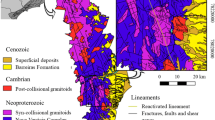Abstract
It is known that foundation problems are caused by the dissolution of gypsum due to both chemical and mechanical processes. In order to investigate the combined effect of physico-chemical agents on the erodability of gypsum, a series of slake durability tests were carried out on eight different types of gypsum using testing solutions with different pH values. XRD, chemical and petrographical analyses, and basic strength tests such as unconfined compression, Brazilian tensile, and point load were performed on the eight rock types. The slake durability results ranged from medium to very high under the different pH conditions but it was concluded that the slake durability of gypsum is independent of the pH of the testing solution. Mineralogical composition and fabric are considered to have a greater influence on the slake durability of gypsum.
Résumé
On sait que différents problèmes de fondation d’ouvrages résultent de processus de dissolution de gypse. Afin de comprendre les effets combinés des agents physico-chimiques sur les processus d’érosion-dissolution du gypse, une série d’essais de durabilité a été mise en oeuvre sur huit types de gypse avec des solutions tests de différents pH. Des analyses chimiques et pétrographiques et des mesures diffractométriques RX ainsi que des essais classiques de résistance mécanique tels que l’essai de compression simple, l’essai de traction brésilien et l’essai entre pointes ont été réalisés sur huit types de roches. Les essais de durabilité ont donné des résultats variables pour les différents pH utilisés, mais il est apparu que les résultats de cet essai ne dépendaient pas du pH de la solution utilisée. La composition minéralogique et la texture de la roche gypseuse ont une plus grande influence sur les résultats de cet essai de durabilité.

Similar content being viewed by others
References
Bell FG (1994) A survey of the engineering properties of some anhydrite and gypsum from the north and Midlands of England. Eng Geol (38):1–23
Benito G, Gutierrez M (1988) Karst in gypsum and its environmental impact on the Middle Ebro Basin, Spain. Environ Geol Water Sci 12(2):107–111
Cooper AH (1989) Airborne multispectral scanning of subsidence caused by Permian gypsum dissolution at Ripon North Yorkshire. Q J Eng Geol (22):219–229
Fengxiang C, Mingjiang W (1983) Investigation of the engineering properties of a dam foundation containing gypsum seams. Rock Mech Rock Eng 16:275–280
Franklin JA, Chandra A (1972) The slake-durability test. Int J Rock Mech Min Sci (9):325–341
Freeze RA, Cherry JA (1979) Groundwater. Prentice-Hall, Englewood Cliffs, p 437
Hawkins AB, Pinches GM (1987) Cause and significance of heave at Llandough Hospital, Cardiff — a case history of ground floor heave due to gypsum growth. Q J Eng Geol (20):41–57
Hoek E, Brown ET (1988) The Hoek–Brown failure criterion–a 1988 update.In: Proceeding 15th Canadian symposium on rock mechanics, Toronto, pp 31–38
Hoek E, Wood D, Shah S (1992) A modified Hoek–Brown failure criterion for jointed rock masses. In: Hudson J A (ed) Proceeding Conference Eurock, Chester. Thomas Telford Press, London, pp 209–214
James AN, Cooper AH, Holliday DW (1981) Solution of the gypsum cliff (Permian, Middle Marl) by the River Ure at Ripon Parks. North Yorkshire, Newyork, Proc Yorkshire Geol Soc (43):443–450
Johnson RB, DeGraff JV (1988) Principles of engineering geology. Wiley p 497
Kocman V, Foley LM (1987) Certification of four North-American gypsum rock samples type—calcium sulphate dihydrate, CaSO4·2H2O, gyp-a, gyp-b, gyp-c, and gyp-d. Geostand Newslett (11):87–102
Luong MP (1984) Damaging settlements of a building due to gypsum dissolution. In: International conference on case histories in geotechnical engineering, St. Louis, MO, USA, pp 27–30
Papadopoulos Z, Kolaiti E, Mourtzas N (1994) The effect of crystal size on geotechnical properties of Neogene gypsum in Crete. Q J of Eng Geol (27):267–273
Rahn PH, Davis AD (1996) Gypsum foundation problems in the Black Hills area, South Dakota. Environ Eng Geosci 2(2):213–223
Acknowledgment
The authors wish to thank Dr. Israfil Kayabali for XRD and chemical analyses. Dr. Erdogan Tekin kindly examined the thin sections and provided petrographical determinations. Part of the experimental works was carried in the laboratories of Gazi University Civil Engineering Department. Mr. Hasan Kezer deserves thanks for conducting part of the experiments. Thanks are extended to the directors of ABS and Biltepe companies for supplying blocks of gypsum.
Author information
Authors and Affiliations
Corresponding author
Rights and permissions
About this article
Cite this article
Kayabali, K., Beyaz, T. & Kolay, E. The effect of the pH of the testing liquid on the slake durability of gypsum. Bull Eng Geol Environ 65, 65–71 (2006). https://doi.org/10.1007/s10064-005-0027-9
Received:
Accepted:
Published:
Issue Date:
DOI: https://doi.org/10.1007/s10064-005-0027-9




